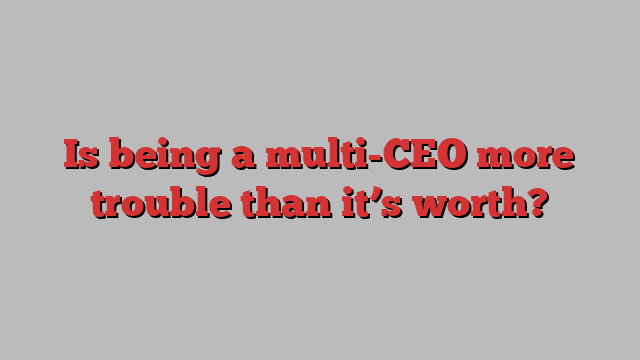
Unlock the Editor’s Digest for free
Roula Khalaf, Editor of the FT, selects her favourite stories in this weekly newsletter.
“I don’t wish this on anyone,” is what Carlos Ghosn once said about simultaneously taking on the chief executive roles at carmakers Renault and Nissan. Being the CEO of one company is all-consuming, so how have some business leaders done the unfathomable — willingly taking on two or more?
A new study sought to understand how multi-CEOs — defined as those who hold more than one chief executive position at once — got there in the first place and how their companies managed to win over shareholders and the public.
Researchers at TU Dortmund University and HEC Lausanne scrutinised the career trajectories and tactics deployed by “celebrity CEOs” — Elon Musk (Tesla and SpaceX), Jack Dorsey (Twitter and Square) and Steve Jobs (Apple and Pixar), alongside Ghosn. Their thinking is that shareholders should be attuned to potential red flags to ward against such arrangements.
The academics found there was usually a time gap between appointments, enabling a chief executive to establish their competency and personal legitimacy in their first top job. By this point it is likely they have built a rapport with board directors as well as top executives and the idea is socialised internally.
Among the interpretations of the CEOs’ behaviours, the authors add that candidates and their boards often acknowledge that such arrangements are undesirable, even if there are no conflicts of interest. Public searches for a new chief executive of the second company using external recruiters is also likely to be a feature.
Then, even if directors and the CEO themselves find that there is seemingly no choice but to take on the additional role, they emphasise the exceptional circumstances and unique talents of the individual. Boards are reluctant to set these arrangements in stone and stress the temporary nature of the multi-CEO model.
In addition, the study finds that not only do these CEOs vocalise how stressful it is and how great the workload is, they also rely on a set of lieutenants who they praise publicly, helping them to split their time across the companies’ headquarters.
Pay also becomes a touchstone. Often the chief executive will not take any pay or accept only stock-based compensation to appease shareholders and show alignment of interests for those who may fear that the individual cannot commit the same amount of time to a company as they should. Voting rights held by CEOs can of course enable some to take on multi-roles.
The conclusion of the researchers is that these arrangements “should not exist” as the responsibilities put on an individual across multiple companies far exceeds any one person’s capacities. “A CEO’s position places extraordinary demands on an individual,” the authors say. “No other individual in the firm wields comparable power or has such a breadth of responsibilities.”
Jeff Bezos (Amazon and Blue Origin) and Warren Buffett (Berkshire Hathaway and Salomon Brothers) are not in the study but are among other top-tier examples. It has to be noted that multi-CEOs tend to be men.
“It could also be that multi-CEOs are a bit of a special personality, maybe more narcissistic and overconfident,” said Lorenz Graf-Vlachy, professor for Strategic Management and Leadership at TU Dortmund University and one of the authors. “There is research to suggest that these traits are more prevalent in men than in women.”
One argument in favour of such set-ups is that distributed leadership models are more prevalent as boards look to reduce “key person” risk at the top. In turn, chief executives have more of a figurehead role in today’s business world, rather than being an operational manager scrutinising the minutiae of everyday business. And in fact, some individuals can extend their existing good track record in their second or third role.
Yet the CEO still directly affects strategy, performance and public perception and that individual is the chief motivator of staff. Employees fundamentally want one person to turn to. A partially absent visionary is not ideal.
As the sheer number of crises facing corporations seem to proliferate, the mere perception that a CEO is diverted can be hugely damaging. That is why the trend of CEOs fulfilling external board roles is such a growing concern.
Speaking about multi-CEOs, Ann Hiatt, a consultant to CEOs who formerly worked directly for Bezos, says “If you are going to do it you have to have incredibly empowered delegates and be consistent and thoughtful in your management style.” She adds: “I’m sceptical that anyone is able to do it well for long.”